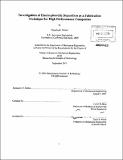Investigation of electrophoretic deposition as a fabrication technique for high performance composites
Author(s)
Palmer, Timothy R. (Timothy Richard)
DownloadFull printable version (10.55Mb)
Other Contributors
Massachusetts Institute of Technology. Dept. of Mechanical Engineering.
Advisor
Cullen R. Buie.
Terms of use
Metadata
Show full item recordAbstract
Electrophoretic deposition (EPD) is a colloidal processing method for the deposition of materials from charged nanoparticles suspended in solution with the application of an external electric field. It is an increasingly popular manufacturing method for engineered materials because of its low cost, simple equipment, flexibility, and efficiency. Yet, little research has been done in the area of composite material fabrication using EPD to infiltrate porous substrates (known as electrophoretic infiltration, or EPI). In addition, what work has been done has focused on 2-D porous substrates such as fiber mats or porous membranes. This thesis endeavors to demonstrate the applicability of EPD for the infiltration and coating of porous materials to create advanced composites. The underlying theory of EPD is discussed to give foundation for experiment parameters. Two sample materials, boron carbide and silicon dioxide, are deposited within and on commercially available porous stainless steel filter discs using constant voltage DC EPD. Surfaces are characterized using a scanning electron microscope (SEM) and energetic dispersive x-ray (EDX)/Auger spectrometers to visualize coating quality and penetration of the material into the substrate. Limitations of EDX/Auger spectroscopy are briefly discussed with respect to the analysis of boron carbide. After the first set of experiments using DC EPD, the study is expanded to include pulsed DC EPD. Pulsed DC EPD is a valuable technique for mitigating bubble formation due to electrolysis in aqueous suspensions, thus reducing macropore generation from gas evolution. The ability of EPD to infiltrate into pores is confirmed by visual inspection of samples under a SEM and EDX. At low voltage, the deposited mass in constant voltage EPD increases linearly with time while at high voltage it asymptotically approaches a maximum yield of 1.988 grams. Pulsed EPD experiments demonstrate a reduction in deposition yield but also elimination of pore generation in the low voltage case. A nondimensional parameter, [delta]*, relating electrophoretic kinetics and diffusion is derived which improves process design for pulsed EPD cells.
Description
Thesis (S.M.)--Massachusetts Institute of Technology, Dept. of Mechanical Engineering, September 2011. "September 2011." Cataloged from PDF version of thesis. Includes bibliographical references (p. 105-108).
Date issued
2011Department
Massachusetts Institute of Technology. Department of Mechanical EngineeringPublisher
Massachusetts Institute of Technology
Keywords
Mechanical Engineering.